Can’t touch this: Unusual venomous creatures
Scientists study a cast of creatures to learn how to use toxins to treat pain and disease
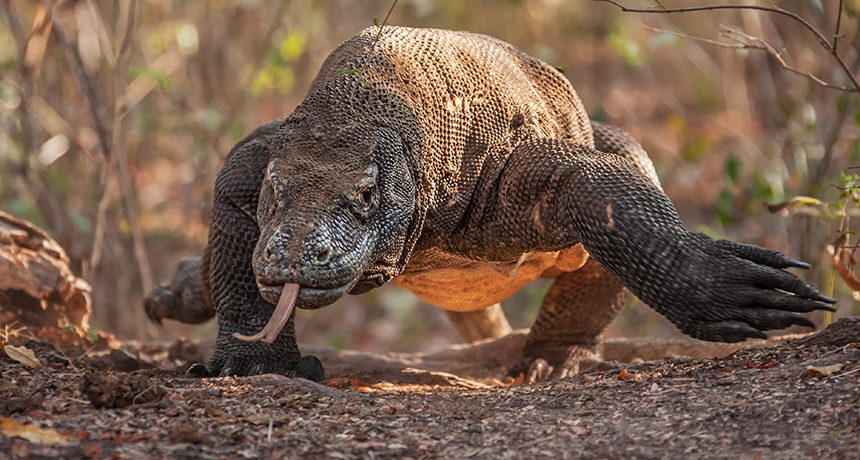
This Komodo dragon is the world’s heaviest lizard. It also has venom glands on each side of its mouth that can make its bite deadly.
kiwisoul/iStockphoto
Even behind thick glass at the zoo, rattlesnakes look dangerous. Their coiled bodies remind you of lightning-fast strikes that can lead to pain and death. Australian funnel-web spiders in the next exhibit make your skin crawl too. Their deadly black fangs actually reflect the dim light. After you’ve passed black mamba snakes, brown recluse spiders and bark scorpions, all of the zoo’s dark corners seem treacherous.
Then you walk into the sunshine and visit the outdoor exhibits. You smile as the Komodo dragon — at up to 300 pounds (136 kilograms), the world’s heaviest lizard — plays tug-of-war with its keeper. In the bird exhibit, hooded pitohuis (pit-eww-ease) from Papua New Guinea flutter to the top perch in a colorful flurry of orange and black feathers. Their song fills the air. A duck-billed platypus, a strange Australian mammal, swims in quick circles in its murky pond while hunting for crustaceans. You’ve forgotten about the venomous snakes and spiders.
However, even lizards, birds and mammals sometimes arm themselves with chemical weapons. You’ve just walked past three examples. They each possess powerful poisons. And these interest scientists not only because of how the chemicals aid in the animals’ defense but also because modified versions of these weapons may one day aid medicine.
Big lizard, deadly bite
Maybe you’re not surprised about Komodo dragons. You’ve probably heard that these lizards, found on just a few small islands in the southwestern Pacific, kill with a bacteria-ridden bite. Scientists, too, used to believe that story. The dragon’s teeth lack the grooves typically seen in venomous reptiles. But how dragons actually destroy prey is far more interesting.
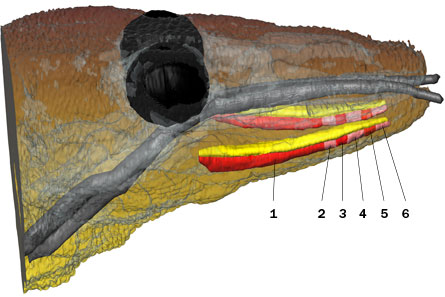
In 2009, biologist Bryan Fry at the University of Queensland in Australia stuck the head of a dead, preserved Komodo dragon into an MRI machine. MRI stands for magnetic resonance imaging. Scientists and doctors use MRIs to create a detailed view of internal soft structures like the brain and heart, muscles and cancerous tumors.
Those MRI images revealed a big surprise: six venom glands on each side of the dragon’s mouth.
Dragons have a unique venom-delivery system. No grooved fangs for them. Instead, they puncture the flesh of prey with sharp, sawlike teeth. When prey pull away, dragons pull back. This action allows venom secreted from glands behind their teeth to ooze into the wound. Dragons then eat their poisoned victims. Among Komodo dragons, scoring a meal can look a lot like a game of tug-of-war. I wonder if zookeepers know that.
A heart-stopping bird
As you admire the hooded pitohui, toxins — poisonous substances produced by living things — don’t cross your mind. But they should. Though the songbirds have easy-to-spot feathers, snakes and hawks of Papua New Guinea, a lush island country in the southwestern Pacific, leave them alone. Even bird lice, which crawl over similar birds in the same region, avoid hooded pitohuis. And local human hunters, who happily eat other birds, avoid the pitohuis.
John Dumbacher, an ornithologist (a scientist who studies birds) at the California Academy of Sciences in San Francisco, discovered why in 2009. Holding the birds made him sneeze and itch; it also made his eyes water. Predators foolish enough to eat a hooded pitohui suffer worse consequences. High levels of batrachotoxin, the same toxin used by poison dart frogs, are found in pitohui muscle, heart and liver. If eaten, the toxin interrupts the normal function of a predator’s nerve cells, eventually causing the diner’s heart to stop beating.
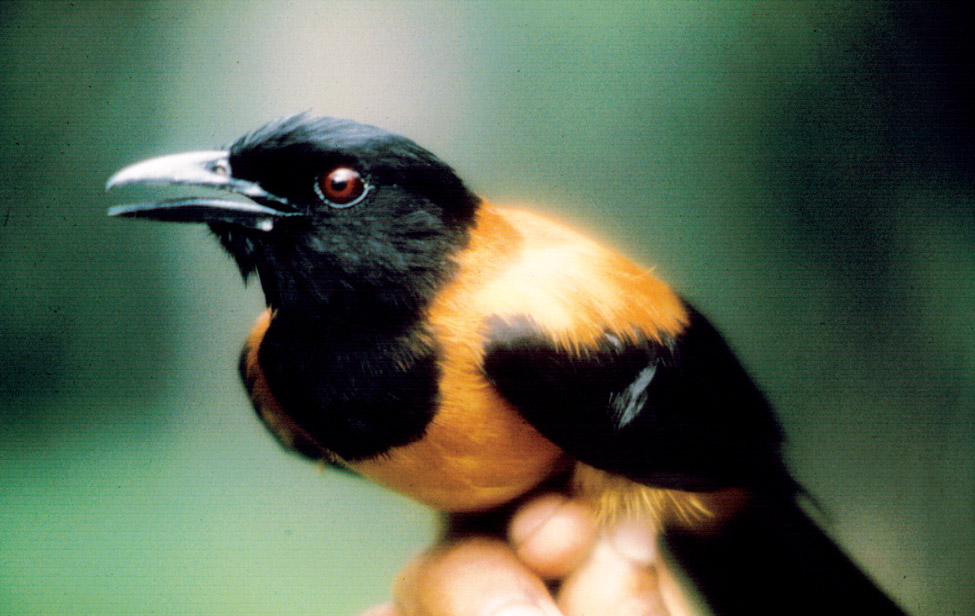
Scientists don’t know how these small birds keep large amounts of batrachotoxin in their tissues without dying. But they’re looking into it. “Right now we’re especially interested in studying how pitohuis evolved resistance to toxins,” said Dumbacher. “Most animals are poisoned by pitohui toxins. Why are pitohuis NOT poisoned?”
Scientists do know, however, how the bird acquires the useful poison. Hooded pitohuis and other toxic birds (four other species of pitohuis and the blue-capped ifrita) eat choresine beetles, which themselves contain batrachotoxin.
“In fact, many toxic animals and insects acquire their toxins from their diet,” Dumbacher explains. “Think of monarch butterflies eating toxic milkweed, or poison dart frogs — like the pitohui — eating choresine beetles.”
Mammals’ toxic spit and paralyzing poisons
Back at the zoo, you move away from the lethal birds and head toward furry critters. Mammals don’t use venom, right? Wrong.
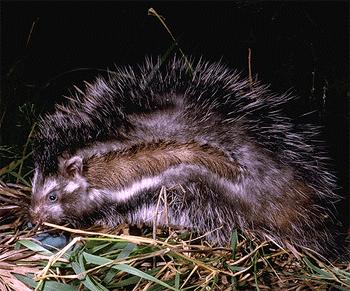
In 2011, Jonathan Kingdon, a biologist at the University of Oxford in England, discovered that the African crested rat can poison anything that touches it. But it doesn’t have venom glands and it doesn’t eat other venomous animals.
So how does the rat become venomous? It chews up toxic tree bark and slathers its now-toxic saliva over specialized hairs.
When a predator approaches, the rat flashes a warning: It flares long, white hairs on its otherwise black flanks. It arches its back and hisses. If all of this doesn’t deter the predator and it eats the rat, the diner becomes uncoordinated, froths at the mouth and sometimes even dies. Kingdon once watched a dog almost die after biting an African crested rat. The dog quivered in fear the next time it saw such a rat; such a near-death experience can prove a remarkably effective predator deterrent.
The African crested rat isn’t the only toxic mammal. Everyone agrees that platypuses are weird. This mammal lays eggs but nurses its young through specialized belly hairs. It hunts prey by using its duckbill to sense electrical currents (called electroreception). Now science can add another item to the bizarre-things-about-platypuses list: They use venom that they make themselves from scratch — just like venomous snakes do.
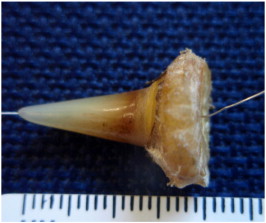
Platypuses don’t use their poison to catch food — shrimp, crayfish and worms — or to avoid becoming food. Crocodiles, Tasmanian devils, dogs and raptors eat platypuses without becoming poisoned. And that caused scientists to wonder what purpose platypus venom serves.
The answer comes from several observations made by biologist Camilla Whittington and her colleagues at Australia’s University of Sydney in 2009.
Her first clue: Only male platypuses produce venom. Just above each webbed hind foot, males grow a bony spur that can deliver a poisonous strike. Second, in the breeding season, males’ venom glands swell in size, as do their testes, which are reproductive organs. Third, the venom doesn’t kill other platypuses (though it can kill large dogs if they attack during platypus breeding season). But the Sydney biologists noted that when fighting over a mate, male platypuses wrap their hind legs around each other, driving venom-injecting spurs into flesh. Victims suffered temporary paralysis of their hind legs.

These observations suggest that males use venom for mating. A male with paralyzed legs can’t fight his rivals —or win mates.
Nature offers several similar strategies. Male walruses use tusks to fight each other during the breeding season. Male bighorn sheep use, well, big horns to fight over females. The winners of these contests gain a lot more mating opportunities than do the losers.
Toxins as painkillers, disease-fighters
Scientists have lately been taking lessons from these animal poisons. The researchers’ goal: to save human lives.
Animal venoms have been used as a blueprint for developing a number of new drugs, including those that treat heart disease and chronic pain, says Emily Wong, a biologist at the University of Sydney.
Here’s why: Toxins are tricky. They are proteins that appear similar to the good proteins in our bodies that control cellular activity. Toxins are so similar to good proteins that they cause serious problems by telling cells to do the wrong things in the wrong places at the wrong times. For example, some toxins may tell blood cells to clot when they shouldn’t, or to not clot when clotting is exactly what the cells need to do. Some toxins tell nerve cells to fire wildly, others to shut down when they shouldn’t. Toxins can even send blood pressure through the roof or though the basement, when it should be hovering around normal. In nature, toxins destroy prey by hijacking their cells.
How toxins twist a normal biological message into something deadly interests scientists who want to control that deadly twist for medical uses. For example, biochemist Bruce Livett at the University of Melbourne in Australia studies conotoxins (cone-oh-tox-ins) from marine cone snails. Particular ingredients in these poisons affect receptors, molecular switches, on nerve cells. Livett believes medicine could borrow those ingredients to block pain in people more effectively than current drugs can.
Pharmaceutical companies agree and are currently developing a class of drugs based on marine cone snail venom for the treatment of pain.
Even the paralyzing poison of platypuses is under investigation. This venom “may lead to treatments for a range of diseases, Wong says. “Maybe it can lead us to new painkillers, too.”
Other venoms have served as the inspiration for drugs already being used by doctors. For example, doctors prescribe the drug eptifibatide (ep-teh-fib-eh-tide) to many victims of heart attacks, which are caused by blood clots. It was modeled on a particular toxin in rattlesnake venom that stops blood clotting.
Over millions of years, nature has created an unimaginable number of toxic cocktails. Every venomous snake, scorpion, beetle, bird, lizard, platypus and rat discovered by scientists adds to the suite of nature’s chemical killers that could one day improve our quality of life.
What can kill us can also save us — once we learn to control it.
Power words (Adapted from the New Oxford American Dictionary)
MRI: MRI stands for Magnetic Resonance Imaging. MRI is used in medicine to create a detailed view of internal soft structures like the brain, muscles, the heart and cancerous tumors.
Predation: A term used in biology and ecology to describe a biological interaction where one organism (the predator) hunts and kills another (the prey) for food.
Electroreception: An aquatic animal’s ability to detect electric fields. Platypuses use electroreception to find small creatures like crayfish and worms to eat. Since platypuses live in murky water and can’t see very well, they rely primarily on electroreception to find food.
Cell Membrane: Separates the inside of a cell from the outside of it. Some particles are permitted to pass through the membrane.
Nerve cells: Also called neurons. Electrically excitable cells that send and receive information by electrical and chemical signaling.
Receptors: Molecular switches that dot the brain’s sensory nerves and the surface of neurons.
Crustacean: An aquatic animal, such as a shrimp, lobster or crab, that has a hard shell and several pairs of legs.
Gland: A body tissue that removes substances from the blood and then alters and secretes them for further use in or removal from the body.







